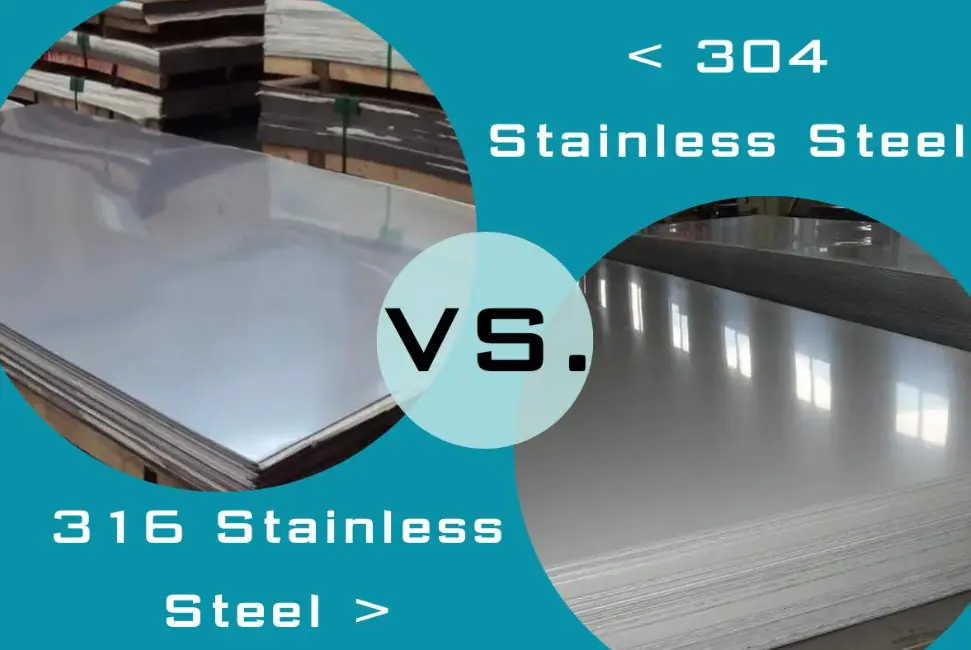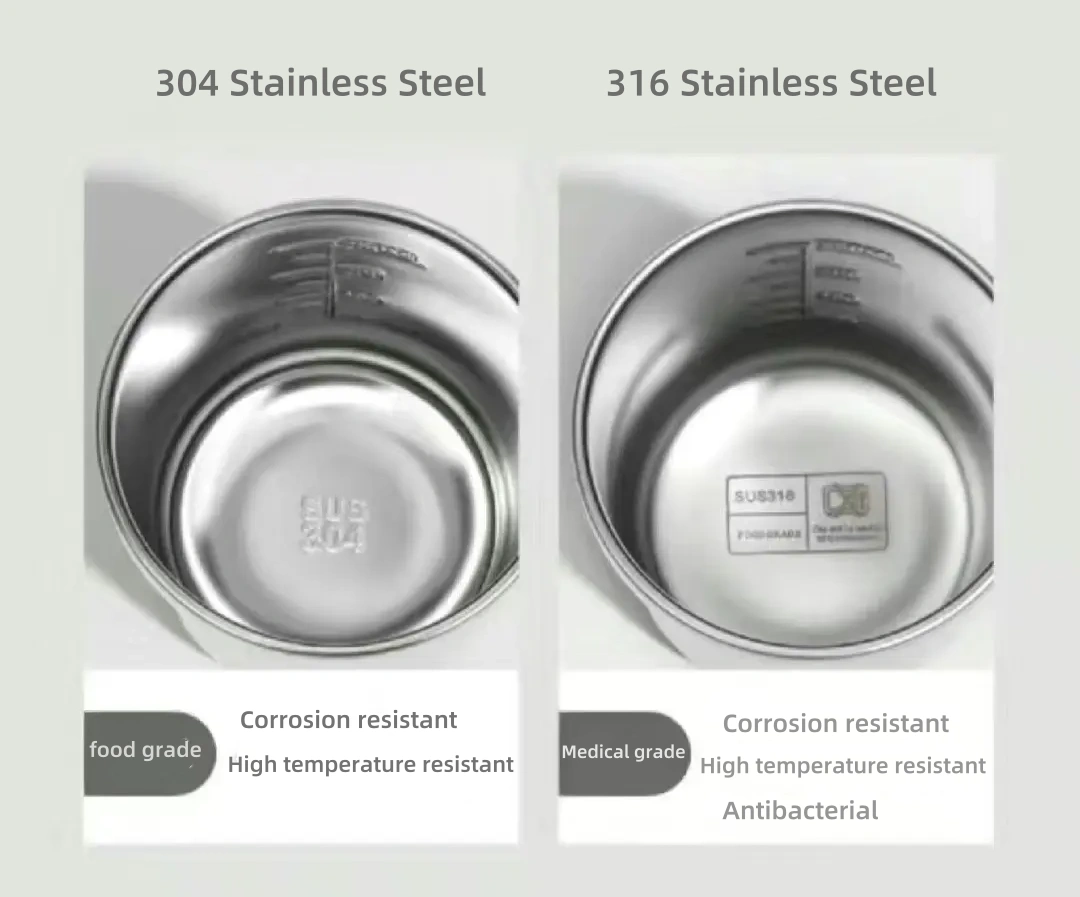스테인리스 스틸 제품은 일상 생활에서 널리 사용되어 왔지만, 다양한 소재를 접할 때 자신에게 맞는 소재를 선택하는 방법을 모르는 사람이 많습니다. 하지만304와 316은 다양한 용도로 널리 사용되는 두 가지 일반적인 스테인리스 스틸 유형입니다. 에 속하는 오스테나이트 등급. 그러나 구성과 최적의 사용 환경에는 몇 가지 주요 차이점이 있습니다.

화학 성분
304 스테인리스 스틸은 주로 18% 크롬과 8% 니켈로 구성됩니다. 304를 기준으로 316 스테인리스 스틸은 2% 몰리브덴 원소를 추가하여 316 스테인리스 스틸의 내식성을 높입니다. 더 우월합니다.
다양한 내식성
304에는 9% 니켈이 함유되어 있고 316에는 12% 니켈이 함유되어 있습니다. 몰리브덴 원소가 추가되어 316 스테인리스 스틸의 내식성, 특히 염화물 부식에 대한 내식성이 304 스테인리스 스틸보다 훨씬 우수합니다. 따라서 316 스테인리스 스틸은 염화물이 다량 함유된 해양 환경과 같은 일부 특수한 환경에서 더 나은 성능을 발휘합니다.
애플리케이션
304 스테인리스 스틸과 316 스테인리스 스틸은 모두 식품 등급 소재이지만 적용 분야는 다릅니다. 304 스테인리스 스틸은 다음에 널리 적용됩니다. 주방용품 그리고 조리기구및 우수한 가공 성능과 인성으로 인해 일부 산업 분야에서 널리 사용되는 반면 316은 다음과 같은 분야에서 널리 사용됩니다. 의료 기기, 식품 산업, 의료 산업내식성이 뛰어나 고온 또는 중공업 환경에서도 사용할 수 있습니다.
스테인리스 스틸 304 대 316 가격
316 스테인리스 스틸은 식품 등급에 속하기 때문에 성능과 내식성이 우수하므로 316 스테인리스 스틸의 가격은 304 스테인리스 스틸보다 비싸며 316 스테인리스 스틸은 평균적으로 304보다 약 20%-30% 더 비쌉니다.
304가 있는지 316이 있는지 어떻게 알 수 있나요?
1. 304와 316 스테인리스 스틸을 눈으로 볼 때 일반적으로 차이는 없지만 둘 사이의 가격 차이는 여전히 상당히 큽니다. 316은 식품 등급에 속하고 내식성이 더 우수하기 때문에 가격이 304보다 비쌉니다.
2. 304와 316에 첨가되는 화학 성분이 다르기 때문에 전문 스테인리스 스틸 용액을 사용하여 구분할 수도 있습니다. 스테인리스 스틸에 약을 떨어뜨리면 304 소재의 표면은 일반적으로 약간 붉은 색으로 변하고 316 소재는 검은 색으로 변합니다.
3. 스테인리스 스틸이 304 재질에 속하는 경우 자석에 끌릴 수 없습니다. 그러나 이 방법의 정확도는 상대적으로 낮습니다.
요컨대, 가정용으로 만 사용하는 경우 304의 특성도 가정용 표준과 완전히 일치하기 때문에 304 재료로 충분하며 316 재료의 비싼 가격을 피할 수도 있습니다. 304 제품 만 구입하면 일상 생활을 충족하기에 충분합니다.

주방용품 제조업체는 304 스테인리스 스틸로 설계 및 제조합니다.
주방용품 제품을 설계할 때는 디자인 미학, 기능성, 제조 가능성, 비용 관리 등을 종합적으로 고려해야 하며, 이를 위해서는 다음과 같은 사항이 필요합니다. 주방용품 제조업체 304 스테인리스 스틸의 성능에 대해 잘 알고 있습니다.
디자인 미학
304 소재 특성 및 성형
304 스테인리스 스틸은 인장 강도와 인성이 우수합니다. 최신 제조 장비는 주방 용품이나 조리기구를 다양한 모양으로 디자인 할 수 있으며 전문적인 주방용품 제조업체 는 제품을 유선형으로 디자인하여 외관이 좋을 뿐만 아니라 사용자의 그립감, 픽업 및 기타 사용자 경험도 더 좋습니다.
표면 처리 방법
또한 스테인리스 스틸은 냉간 압연, 열처리, 산세 및 기타 방법으로 처리되며 표면이 더 매끄럽고 미적이며 사용자 경험이 더 좋습니다. 물론 일반적인 매끄러운 표면 외에도 일부 주방 용품 제조업체는 8K 미러 및 브러시 표면이있는 스테인리스 스틸도 생산합니다.
디자인 미학의 중요성
요컨대, 디자인 미학은 스테인리스 스틸 주방 용품의 디자인 초기 단계에서 고려해야 할 중요한 요소이며, 이는 소비자에게 제품에 대한 인상과 관련이 있으며 사용자 경험을 어느 정도 결정합니다.
기능 설계
기능성은 의심할 여지없이 제조업체가 주방용품을 디자인할 때 핵심적인 역할을 합니다. 따라서 주방용품 제조업체는 제품을 디자인할 때 제품의 실제 사용 기능에 초점을 맞춰야 합니다. 예를 들어 냄비의 열전도 효과, 뚜껑의 밀봉, 손잡이의 인체공학적 디자인 등이 있습니다. 열전도율이 좋으면 열이 재료에 빠르고 균일하게 전달될 수 있습니다. 뚜껑을 잘 밀폐하면 재료의 신선함과 영양을 그대로 보존할 수 있습니다. 편안하고 잡기 쉬운 손잡이는 장시간 요리의 피로를 줄여줍니다. 냄비를 예로 들면, 냄비 바닥을 두꺼운 바닥과 얇은 벽 구조로 설계하여 빠르고 고른 열전도를 달성하여 조리 과정에서 에너지를 절약하고 고효율을 달성 할 수 있습니다.
